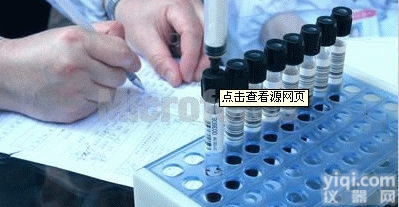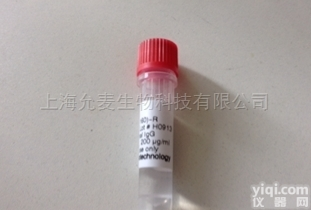产品名称:遗传性耳聋β-tectorin抗体,Anti-TECTB抗体
中文名称:遗传性耳聋β-tectorin抗体
英文名称:Anti-TECTB
产品编号:byk-11067R
产品规格:0.1ml/0.2ml
产品用途:科研实验
性 状: Lyophilized or Liquid
浓 度: 1mg/1ml
亚 型: IgG
贮 存: 贮存于-20℃.
相关标记: HRP Biotin Gold RBITC AP FITC Cy3 Cy5 Cy5.5 Cy7 PE PE-Cy3 PE-CY5 PE-CY5.5 PE-CY7 APC Alexa Fluor 350 Alexa Fluor 488 Alexa Fluor 555 Alexa Fluor 647
我公司拥有领先的细胞服务技术,先进的仪器设备和专业的ELISA检测试剂盒、生物索标记、荧光索标记、酶标记等,广泛用于多种分析研究与技术测定。欢迎来电咨询,我们将竭诚为你服务!
遗传性耳聋β-tectorin抗体,Anti-TECTB抗体 相关产品:
肌管素相关蛋白2抗体 Anti-MTMR2
朊蛋白DPL抗体 Anti-Doppel/DPL
磷酸化致癌基因C-Myc抗体 Anti-phospho C-Myc(Thr58/pSer62)
致癌基因抗体 Anti-MTLC
组蛋白H1.4样蛋白抗体 Anti-Histone H1.4
芳香基硫酸酯酶家族蛋白1抗体 Anti-ARSI
肝细胞生长因子受体抗体 Anti-Met/c-Met
巨噬细胞甘露糖受体抗体 Anti-MRC1/CD206
c-mer原癌基因酪氨酸激酶抗体 Anti-C-Mer/MERTK
C型凝集素结构域家族1成员B抗体 Anti-CLEC2/CLEC1B
活化转录因子6β抗体 Anti-ATF6 beta
C型凝集素结构域家族1成员A抗体 Anti-CLEC1/CLEC1A
活化转录因子5抗体 Anti-ATF5
转录因子蛋白SIM1抗体 Anti-SIM1
钙激活氯离子通道4抗体 Anti-CLCA4
D型产气荚膜梭菌抗体 Anti-Clostridium perfringens type D
液泡蛋白分选受体SORCS抗体 Anti-SORCS1
酪蛋白激酶2相互作用蛋白1抗体 Anti-CKIP-1
高分子量细胞角蛋白抗体 Anti-Cytokeratin 13/CK-HMW
补体C1q和肿瘤坏死因子相关蛋白5抗体 Anti-CTRP5
抗体规律
(1)初次反应产生抗体:当抗原一次进入机体时,需经一定的潜伏期才能产生抗体,且抗体产生的量也不多,在体内维持的时间也较短。
(2)再次反应产生抗体:当相同抗原第二次进入机体后,开始时,由于原有抗体中的一部分与再次进入的抗原结合,可使原有抗体量略为降低。随后,抗体效价迅速大量增加,可比初次反应产生的多几倍到几十倍,在体内留存的时间亦较长。
(3)回忆反应产生抗体:由抗原刺激机体产生的抗体,经过一定时间后可逐渐消失。此时若再次接触抗原,可使已消失的抗体快速上升。如再次刺激机体的抗原与初次相同,则称为特异性回忆反应;若与初次反应不同,则称为非特异性回忆反应。非特异性回忆反应引起的抗体的上升是暂时性的,短时间内即很快下降。
遗传性耳聋β-tectorin抗体,Anti-TECTB抗体 产品详情:
Beta-tectorin is a 329 amino acid secreted protein that contains one zona pellucida (ZP) domain. While it may form homomeric filaments after self-association, Beta-tectorin may also form heteromeric filaments when it associates with ?tectorin. The presence of a hydrophobic C-terminus preceded by a potential cleavage site strongly suggests that tectorins are synthesized as glycosylphosphatidylinositol-linked, membrane-bound precursors. Tectorins are targeted to the apical surface of the inner ear epithelia and proteolytically released into the extracellular compartment. Beta-tectorin is one of the major non-collagenous components of the tectorial membrane. The tectorial membrane is an extracellular matrix of the inner ear that covers the neuroepithelium of the cochlea and contacts the stereocilia bundles of specialized sensory hair cells. Sound induces movement of these hair cells relative to the tectorial membrane, deflects the stereocilia and leads to fluctuations in hair-cell membrane potential, transducing sound into electrical signals.
 遗传性耳聋β-tectorin抗体,Anti-TECTB抗体
遗传性耳聋β-tectorin抗体,Anti-TECTB抗体
 遗传性耳聋β-tectorin / 遗传性耳聋β-tectorin抗体
遗传性耳聋β-tectorin / 遗传性耳聋β-tectorin抗体
 Anti-DFNB31抗体 常染色体隐性遗传性耳聋型31蛋白抗体
Anti-DFNB31抗体 常染色体隐性遗传性耳聋型31蛋白抗体
 Anti-DFNB31抗体 常染色体隐性遗传性耳聋型31蛋白抗体
Anti-DFNB31抗体 常染色体隐性遗传性耳聋型31蛋白抗体
 Anti-DFNB31抗体 常染色体隐性遗传性耳聋型31蛋白抗体
Anti-DFNB31抗体 常染色体隐性遗传性耳聋型31蛋白抗体
 Anti-DFNB31抗体,常染色体隐性遗传性耳聋型31蛋白抗体
Anti-DFNB31抗体,常染色体隐性遗传性耳聋型31蛋白抗体
 【Anti-DFNB31抗体,常染色体隐性遗传性耳聋型31蛋白抗体】
【Anti-DFNB31抗体,常染色体隐性遗传性耳聋型31蛋白抗体】
 Anti-Espin/DFNB36抗体,常染色体隐性遗传性耳聋型36蛋白抗体
Anti-Espin/DFNB36抗体,常染色体隐性遗传性耳聋型36蛋白抗体
 碱性磷酸酶(AP)标记的常染色体隐性遗传性耳聋型36蛋白抗体
碱性磷酸酶(AP)标记的常染色体隐性遗传性耳聋型36蛋白抗体
 胶体金标记的常染色体隐性遗传性耳聋型36蛋白抗体
胶体金标记的常染色体隐性遗传性耳聋型36蛋白抗体
 Anti-TECTB抗体,遗传性耳聋β-tectorin抗体说明书
Anti-TECTB抗体,遗传性耳聋β-tectorin抗体说明书
 Anti-TECTB抗体,遗传性耳聋β-tectorin抗体
Anti-TECTB抗体,遗传性耳聋β-tectorin抗体